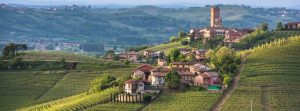Learning about wine
The Freisa, a native Piedmontese vine
 Today we will talk about Freisa. A native Piedmontese grape with black berry, widespread especially in the Asti area, in the Monferrato Casalese area, in the Alessandria area and in the Cuneo area. There are two main varieties: the Freisa Piccola, mainly present in the hilly areas and the Freisa Grossa which is more productive but which, however, produces wines with a minor character.
Today we will talk about Freisa. A native Piedmontese grape with black berry, widespread especially in the Asti area, in the Monferrato Casalese area, in the Alessandria area and in the Cuneo area. There are two main varieties: the Freisa Piccola, mainly present in the hilly areas and the Freisa Grossa which is more productive but which, however, produces wines with a minor character.
The fame of the Freisa
The Freisa is a wine that struggled to carve out a place of excellence. It is located in an area that has to compete with famous wines like those of the Langhe, Barolo and Barbaresco. It was therefore not easy and neither is it currently affirming its identity. Another point against this wine is the fact that it is at the center of a debate: in fact, there are those who consider it quality, long-lived and up to the other wines of Piedmont. But there are also those who do not appreciate it at all and consider it unpleasant.
Currently the Freisa is protected with the Doc Asti and with the Doc Chieri. It then appears in other Piedmontese Doc.
Historical curiosities
At the end of the nineteenth century, the cultivation of Freisa grapes was widespread in the province of Asti and in the Casalese area. When the diseases devastated Italian and European vineyards in the late nineteenth and early twentieth century, production grew. It is in fact a rustic vine, very resistant and generous in terms of productivity.
The wine
It is a very eclectic vine, capable of giving very different wines. The most popular version is certainly the lively one, to drink young. The frozen Freisa, subjected to a few years of aging, are much more elegant and complex wines. The taste is of raspberry, dried rose, macerated red fruits and vanilla.
Fermo can accompany red meat, boiled meat, roasts, game and aged cheeses. The lively, fresher version goes well with cured meats, pasta dishes and main courses based on white meat.
What do you think of this wine? Have you already tasted it? Let me know your opinions about it! Good day!
Ilde





